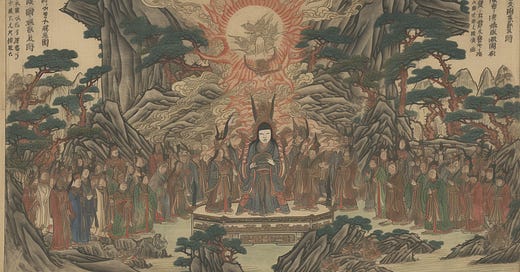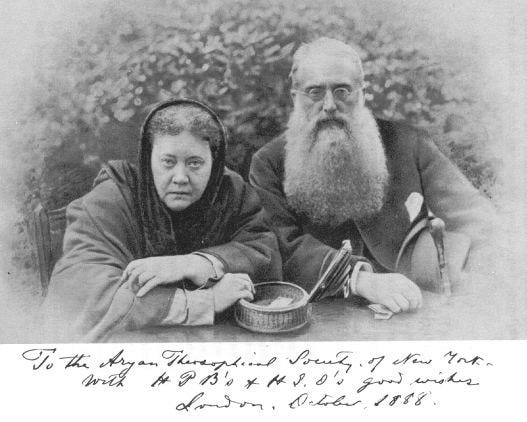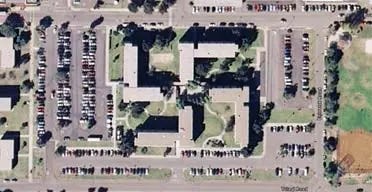The Unoriginal Mythology of Scientology - Is This Plandemonium?
Cults, Mind Control, and Plandemonium, Part 1
"One of the surest tests is the way in which a poet borrows. Immature poets imitate; mature poets steal; bad poets deface what they take, and good poets make it into something better, or at least something different." -T.S. Eliot
Other Plandemonium Tales can be found here at the Campfire.wiki. Find more discussion at the RTE Locals community.
This article will raise more questions than answers. It will serve as a reference for future articles that will connect more dots to the present moment.
The Theosophical Mystical Global Mythology Came First
Understand that I am not an expert on Theosophy, or the larger topics of the esoteric and the occult that adherents study, though I've read about these topics in bits going back to childhood from various books and articles, and within a broader reading of historical topics. I apologize in advance for any fact or interpretation that I stumble with. I'm always happy to take on new sources to expand my understanding.
Now, down the rabbit hole…
The founders of the Theosophical Society professed to be on a journey for a secret brotherhood of spiritual adepts or Masters/Maitreyas (which they somehow knew must exist) among the religions of the world who would combine their knowledge to reformulate an ancient religion that nobody else knew about. The official mission of the Theosophical Society is to serve humanity through cultivation of Ageless Wisdom, spiritual transformation, and the unity of all life. You might think of it as Effective Altruism for people without electronic-media-stunted attention spans, who can handle an element of religious studies that involves recharacterizing all religious mysticism in terms of a single New Age religion.
Before we talk more about Theosophy (serving you since 1875) and the ancient wisdom keepers, let's talk about the messengers—the founders of the Theosophical Society. Though there were seventeen founders, the society largely formed around an immigrant mystic, and a Freemason lawyer and war veteran.
Helena Petrovna Blavatsky was born into an aristocratic family in the Russian Empire (Dnipro, Ukraine, where an important dam was just destroyed amidst the Russian-Ukraine conflict). Here interest in magic led her into a marriage that dissatisfied her. Her escape led to years of world travels—probably on her father's dime—during which she claims to have encountered volumes of esoteric knowledge that inspired the Theosophical claim that the secret knowledges of the various world culture fit together like an ethereal puzzle waiting for humanity to solve, then transform into a higher form.
A second founder was the Freemason Colonel Henry Steel Olcott. As a young man, Olcott took interest in esoteric and paranormal studies after seeing the "Fox Sisters" who spent decades fooling audiences into believing they communicated with spirits until one of them confessed. Prior to the Civil War, Olcott spent some time working as a journalist. Serving during the Civil War, Olcott rose to the rank of colonel, at which point he was transferred to the Department of the Navy. Later, Olcott served as an investigator into the assassination of President Abraham Lincoln. In the early 1870s, Olcott went back to investigating spiritualists such as the "Eddy Brothers", whom he wrote articles about, and who also turned out to be frauds.
Col. Olcott was not the only Freemason among early Theosophists, and Theosophical centers are called lodges, consistent with Mason and Scottish Rites tradition.
Among other things, the Theosophists believe in ancient astronauts, and a progression of seven root races on Earth.

It is interesting that the elevation of the so-called Aryan race motivated Hitler, who similarly took the swastika to represent his own movement.
The similarities between Nazi mythology and Theosophy are striking, and the inscription on the right might be interpreted as a Nazi mission to use everyone's resources in a quest to research and gather the root wisdom of the world. Just like the Theosophists, the Nazis sent explorers searching for archeological evidence of ancient societies and technology to Tibet and in search of Atlantis. For now, I'll leave it to the reader to meditate on that coincidence.
In other news, Australia just announced a ban on the swastika—because the way to deal with Nazi authoritarians is to out-authoritarian them. Now, back to our regularly scheduled program.
After getting the Theosophical ball rolling in New York, Blavatsky and Olcott left for India and converted to Buddhism, which the pair would promote Western through the Theosophical Society branches. Local leadership in India were wary of the Theosophists and felt they were spreading control over India on behalf of England or Western powers. Theosophical Society lodges were quickly spreading through England and the U.S. both during this time period. During that time, Blavatsky came by letters supposedly written by mystical leaders, though there is no solid evidence that the supposed authors actually existed at all. These letters still serve as much of the basis for Theosophy.
Have you ever wondered if occult magic is just the silly elevation of the various skills of performance illusionists, but with the aim of cult control?
If you want to know more of Theosophy, you can find plenty of books on the Theosophical Society's perspectives on the esoteric and the occult. You can also take ten minutes to view this video.
Is the Theosophical Society a religion, a cult, or something else?
Might we describe Theosophy as a multi-level marketing scheme given the lodge dues and educational fees paid in by members who can then rise to the position of lodge leaders and professors of Theosophical "truth".
For the moment, I'd rather not weigh in with an exact description. Instead, I will make the observation that cults tend to draw people in seeking to ascend spiritually beyond their present means—or to fill a spiritual void—for some definition of spirituality. Theosophy certainly draws together knowledge of the world's religions. And perhaps it is noble to search these religions for something greater and potentially universal.
Aside from the religious and paranormal elements, Theosophy declares itself to be a scientific discipline, though perhaps only for those with the "requisite means of perception." If you don't get it, that's probably just because you're lacking a sixth sense, or something like that. You should probably buy some books and take some courses to discover a sixth sense, if you're even equipped. Then you can run or interpret experiments, I'm assuming.
What we can say for certain is that some claims made by Madame Blavatsky that should be verifiable by now, seem like…Astrological fiction, at this point:
On the other hand, some claims by Blavatsky and later theosophists have been questioned. For example, it was stated in The Mahatma Letters to A. P. Sinnett (cf. “Intra-Mercurial planets” in letter 93B; 23B in the Barker ed.) and later by C. W. Leadbeater (The Inner Life, vol 2, p. 186-7) that there was a planet called Vulcan closer to the sun than Mercury. Certainly, at the time of those writings, such a planet was postulated to explain the irregularity in the orbit of Mercury, but such a planet has never been observed and the irregularity can be completely explained by Einstein’s general theory of relativity. This was, in fact, the first of many precise confirmations of that theory. It was also stated in The Mahatma Letters that there is a “king star right behind Jupiter, that no mortal physical eye has ever seen”during historic times and which is responsible for that planet’s red spot (idem). Indeed this statement is so unsupportable that one either has to reject it out of hand or ask whether the statement was an intended to refer to a non-physical celestial body. If the latter, science has at present no means of verifying such a claim. Similarly, there is no scientific means of verifying the claim that each planet is one of a chain of seven planets, most of which are superphysical.
It is unclear why an organization that claims not to be a creed should make speculative claims about the nature of the universe—unless the point is to impress and intrigue people looking to fill a spiritual void. Who would do such a thing?
Apparently, World Economic Forum darling Yuvel Noah Harari mentors young academics who study occult black magic.
Here is Harari's colleague, Professor Huss, on Jewish Theosophy and Kabbalah.
It is surprising how quickly Theosophy took off among not simply mystics and some Christians, but Jews, Hindus, Buddhists, and others.
Scientology and Theosophy: Coincidental Parallels or Spiritual Plagiarism?
As is well known, L. Ron Hubbard captained vessels in the U.S. Navy during World War II. His father served as a Naval officer during World War I. Less well known is Hubbard's involvement in studies of the occult. Sometime (1945) after leaving the Navy, Hubbard went to live with Jet Propulsion Laboratory founder Jack Parsons. Parsons felt impressed by Hubbard's yet-uneducated understanding of occult magic, and noted Hubbard's claim of a guardian angel that Hubbard called "the Empress" who guided him through life.
Parsons initiated Hubbard into Aleister Crowley's magical order lodge, Ordo Templi Orientis (OTO), which originally only Freemasons could join. When OTO co-founder and leader Theodor Reuss passed, Crowley just sort of asserted control over the organization, steering it for his own purposes. Including the Golden Dawn, this was not the first time Crowley infiltrated and took control of a Masonic organization.
At this point, we might stop and point out that Crowley worked for British intelligence who likely directed his activities to some significant degree, and there is significant speculation that the OTO was itself a British operation to inject control over Germany through a mystical secret society. Crowley also infiltrated a German spy organization working in New York, and is said to have arranged the sinking of the Lusitania, which brought the U.S. into the first World War. Whatever the truth, Crowley used the OTO as a platform for magic based on sexual ritual, among other things. And his interests in religious mysticism parallel those of the Theosophical Society, with more sex, drugs, and Dark Triad personality traits more explicitly thrown in.
Eventually, Hubbard left the OTO, taking Parson's girlfriend and money with him—a pretty Dark Triad move if there ever was one. Epic, really. It's one thing to snake a pal's lover. But when that pal is into one of the most infamous Satanic rituals in history—the attempted summoning of the antichrist—it really stands out. And then to use that guy's money while building up your own religion and secret society. That's one for the ages!
Perhaps we are ahead of ourselves now, because Hubbard was not yet at the Scientological starting line. This might also be the right point to stop and examine Scientology's claim that Hubbard's involvement with Parsons and Crowley took place on behalf of the Office of Naval Intelligence (ONI). Scientology haters dismiss this claim as part of Hubbard's generally narcissistic personality. But are they right to do so? Haven't we seen plenty of evidence that Western governments and military intelligence were keen to spy on and influence secret societies and religious organizations—particularly those with cultish practices? And perhaps use those organizations to steer major world events? I plan to continue to examine this question in one or more later articles.
In the meantime, let us consider the less controversial point that Hubbard entered a period of prolific writing. In fact, prolific is an understatement. Hubbard's works include a hundred films and over 500 novels and short stories. I've had friends accuse me of prolific writing from time to time, and having written tens of thousands of pages of articles, classes, and textbooks, I know how crazy it is that Hubbard wrote approximately half a million pages of published work. This is another reason I don't buy into the fully dismissive perspectives of many of the man's critics. Whether or not all of Hubbard's war stories were all true, and whether or not he was an occultist or spy, it seems hard to establish a full character profile of the man without acknowledging a certain level of hard work and creativity—at least within his primary professions. He even wrote…space jazz.
In fact, all that hard work and creativity leads me to think that if anyone was capable of pulling off the creation of a new occult-driven, alien-proselytizing religion with its own embedded secret society and intelligence agency, possibly with ties to military intelligence, L. Ron Hubbard could be that man. All that said, perhaps we should consider the possibility that the author of such voluminous work borrowed some ideas along the way. Hubbard's work included explorations of the paranormal, aliens, magic, and mind control.
Was that the real point?
I suspect that the younger Hubbard was just writing as he explored the world. But the post-war Hubbard might have been a different beast, arranging ideas into what might make believable stories to large numbers of other human beings. And the Theosophical Society may have been his best source for what worked. From the Theosophists and the Freemasons, Hubbard might also have learned the strategy of turning it all into a multi-level marketing scheme. Here is an impressive and powerful list of parallels between Theosophy and Scientology from Jason Colavito:
Swastikas - It's Almost Funny Because It's True
There is a great deal more to come on these topics, which will connect back with the plandemonium of today. In the meantime, let us soak up this overhead view of a Naval Amphibious Base Complex at Coronado (San Diego, California).
Ground-breaking began for the six-building complex at the Coronado US navy base in southern California in 1967. While the original plans called for two central buildings and a single L-shaped barracks, Naval Amphibious Base Complex 320-325 evolved in design. By the time it was finished in 1970 it had four L-shaped buildings - set at right angles. That was when the problem was spotted.
Oh, that's when it was spotted. Good story, bro.
Addendum: A reader pointed out that the Guardian got the story wronger than I had known. There are two additional buildings shaped like airplanes that might be interpreted as attacking the swastika.












Fascinating.
Great research.
I've never been interested in this stuff. It seems like another form of politics. In my view, normal politics first attacks the public space and from there attacks the conscience of individual. The occultists do it in reverse: first they attack the conscience of the individual, and then they attack the public space. Should I call Theosophy "paranormal politics"? But that sounds legitimizing of the evil deeds of normal politics.
As an aside, Crowley was an amateur mountain climber, and made it surprisingly high up K2 (21,500 feet) considering his lack of skill. He also was astute enough to ascertain the Abruzzi spur was the most climbable route--and it turned out to be the route of the first successful ascent.
https://altitudepakistan.blogspot.com/2012/11/k2-first-attempt-1902-expedition.html?m=1